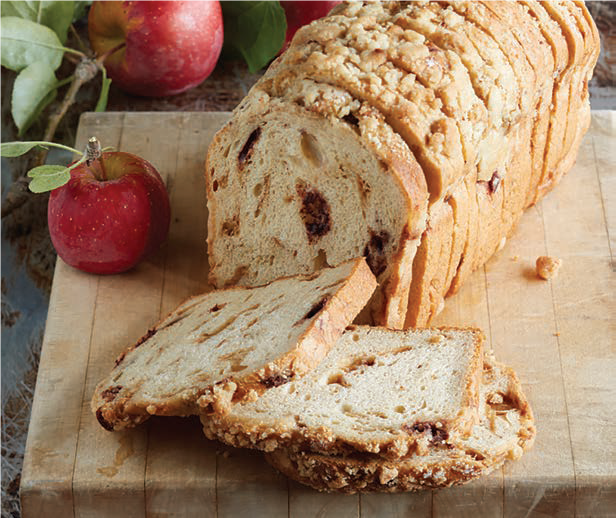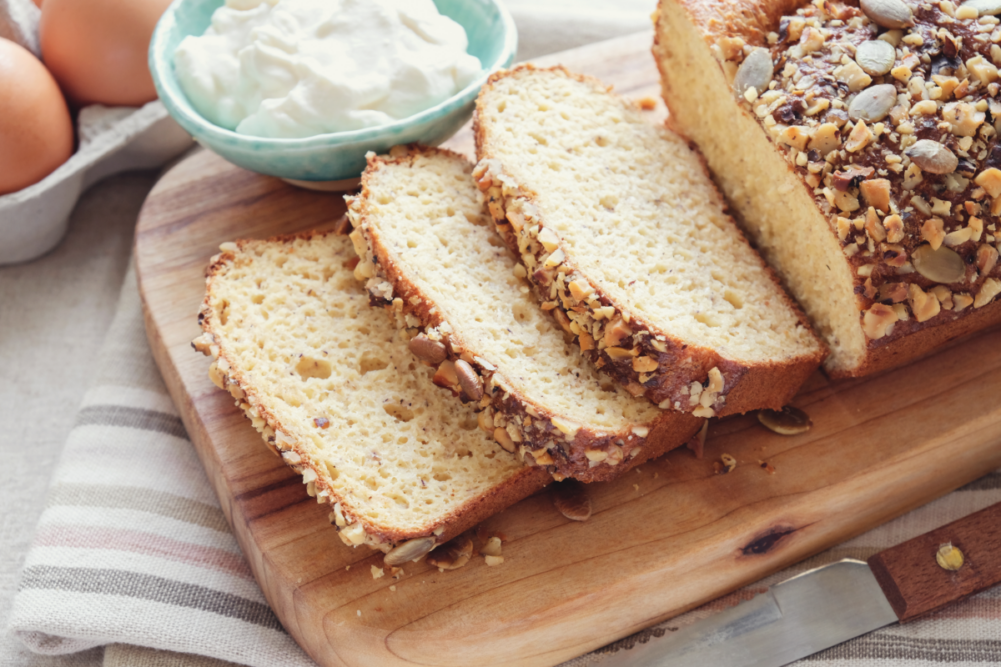CHICAGO — A raisin swirled bagel gets topped with cinnamon-roasted almond slices. A diced apple pumpkin muffin’s streusel contains brown sugar-glazed pumpkin seeds and oat flakes. Pecan praline-coated whey protein clusters decorate and add essential amino acids to a chocolate enrobed sports recovery bar.
Fruits, grains, nuts and seeds along with fabricated bits, chips and chunks — possibly with added protein or fiber — are trending in the baked goods sector. Such inclusions not only provide color, flavor and texture, but they also contribute nutrition and a healthful halo.
Careful consideration
The No. 1 variable is moisture content of both the inclusion and the base product. Barriers such as coatings and glazes may be employed to prevent undesirable moisture migration. Recipes may also need to be adjusted to account for any moisture addition from the inclusion.
After moisture control, lipid oxidation must be addressed. High-fat inclusions such as nuts and seeds can go rancid over time. Again, barriers may assist as well as the addition of antioxidants. Other key attributes to take into account include batter and dough density, baking time and temperature, product pH, water activity of the final baked product, and desired shelf life.
“You need to think about whether you want a burst of color in the crumb or a smear in a dough,” said Deborah Waters, senior business development manager-bakery, Kerry Ingredients. “You need to consider if a melted pocket of maple, for example, is preferred over a more intact toffee chip inclusion after baking. You also need to consider the formula carefully to prevent burning in a pre-bake topping application or if the baked product will go through a freeze-thaw or refrigerated shelf-life cycle.”
Whole-food inclusions
Fruits, grains, nuts and seeds are common in baked goods. Depending on the application, these additions may require slight processing changes to maintain integrity over time or to better perform in baked goods.
“Dried apples, for example, are available in different forms, moisture levels or levels of dehydration, in order to extend the shelf life, supply low-cost transportation and storage, ease handling, and reduce labor,” said Jeannie Swedberg, director of business development, Tree Top Inc. “They also offer a higher degree of food safety due to their reduced water activity.”
These ingredients carry phytonutrients and antioxidants; contribute to dietary fiber; and contain vitamin C, beta carotene, B-complex vitamins and vitamin B6.
Basic dried apple ingredients contain 14 to 26% moisture. If less moisture is required, an intermediate option is in the range of 12 to 18% and a low-moisture version is 2 to 14%. Other fruits are available with similar moisture contents. Depending on the application, dried fruit ingredients require hydration prior to use.
“Our regular moisture level apples, for example, require three- to five-parts water by weight to one-part apple to reconstitute,” Ms. Swedberg said. “This returns them to fresh-cut dimensions. This ratio can be affected by desired end use, processing methods, and the size and style of cut.” Nuts, much like fruit, are available in varied forms. Seeds, on the other hand, tend to be used whole.
“Almonds, for example, are available in several different forms, enabling greater versatility in baking,” said Laura Gerhard, director of strategy and marketing, Blue Diamond Almonds Global Ingredients Division. “Traditional forms include sliced, diced, slivered and split almonds, which can be used in a variety of baked applications, ranging from snacks and bars to more indulgent items like cakes, pies and muffins.”
Nuts and seeds vary in the amount of protein, fiber, vitamins and minerals they contribute. Some are recognized for their heart-healthy fat profiles. They may carry seasonings and coatings, making them customizable to any flavor combination.
“We believe that a growing global interest in plant-based and clean ingredients will continue to create new opportunities for whole food inclusions like almonds,” Ms. Gerhard said.
The power of grains
Grains complement the plant-based trend, with some grains contributing protein, fiber and other nutrients. They may be added to baked goods in their whole grain form or combined with other ingredients.

The Annex by Ardent Mills, for example, has a line of ancient and heirloom grain crisps, including quinoa, amaranth and brown rice. These are used to make clusters, nuggets and grain bites.
“Our quinoa crisps can help add nutritional value to formulations through the protein and fiber they provide,” said Angela Ichwan, senior director and technical lead of The Annex by Ardent Mills. “The light texture and the small diameter of quinoa crisps make them easy to incorporate in a cluster or use as a topping. Because these crisps are low in moisture, it is important to account for potential moisture migration from the baked goods to the crisps, which can cause stale texture or potentially the loss of the grain identity of the crisps.”
Grains can also be added in their pregelatinized form, but that can take some adjustments for water content as they have a higher, rapid moisture rate compared to their non-pregelatinized counterparts, according to Wiwid Paramita, technical sales specialist, Briess Malt & Ingredients Co.
“Partially pregelatinized grain particles not only provide eye appeal and a sense of wholesomeness, but they also add nutrition associated with whole grains,” she explained. “Custom grain blends are a great way to protect intellectual property and differentiate from competitors. Sprouted grains, for example, provide unique flavor and color.”
Corbion helps bakers enhance their applications by adding in interesting or on-trend ingredients while saving them extra time and effort. These include bases for fiber-enriched, low-carb products; mixes that can add vitamins to sports bars; and customizable powder spice and vegetable grain blends.
The company also offers pre-soaked grains with ready-to-use whole and ancient grains, said Yanling Yin, director-bakery applications, Corbion.
These grains are non-GMO and preservative free. They can be flavored and customized to fit any application. These pre-cooked whole grains are offered in a jam-like consistency, and some provide additional sweetness from added sugar or molasses.
“Part of what makes our pre-soaked grains so easy to use is that they can be added to a variety of products at a wide range of temperatures without negative results,” Ms. Yin said.
Dairy-based texture
Dairy proteins can also be added to baked goods in different formats to provide texture and nutrition.
Agropur developed whey protein-based inclusions that can be used in baked products. Not only do they deliver extra protein, but the inclusions also contain no added sugar.
“They add a light and airy texture to baked products,” said Anand Rao, vice president of ingredients innovation, Agropur Ingredients.
Glanbia Nutritionals manufacturers milk protein-based crisp inclusions designed to deliver a hearty crunch, as well as quality dairy protein to nutritional bars. The crisps are designed to withstand the bar-making process as well as keep their integrity throughout the bar’s targeted shelf life.
“The milk protein concentrate in the inclusions is extremely functional in that it withstands an extrusion process and provides a clean dairy flavor requiring no masking,” said Ashley Bacchiarello, director, product strategic management, Glanbia Nutritionals.
A nugget of protein
While dairy provides extra protein to baked goods, other ingredients can also be used to make fabricated inclusions that boost protein content.
DuPont Nutrition & Biosciences offers soy- and pea protein-based nuggets and flakes in a range of protein contents, textures, colors, shapes and sizes. The inclusions can be applied in dough, batter and nutrition bars. If used in a higher moisture system, the nuggets soften over time, so the crunch may get lost through shelf life.

“The most unique nugget family is our 90% protein soy nuggets and 82% cocoa soy protein nuggets, which offer the highest protein content in the industry,” said David Guilfoyle, group manager, bakery, fats and oils, DuPont.
In 2019, Balchem acquired Zumbro River Brands and now offers the company’s signature crisps, which are made from multiple protein sources and flavor combinations. Popular proteins are brown rice, pea protein and whey, alone or in combinations.
Cargill Cocoa and Chocolate offers protein-fortified compounds as inclusions as well as coatings.
“Compound coatings mimic chocolate from a sensory perspective but aren’t required to meet the standard of identity, making them the perfect carrier of functional ingredients such as protein and fiber,” said Katy Cole, technical service manager at Cargill. “There are a variety of technical factors to consider when formulating compounds with added protein or fiber, including flavor and texture. Consumers have specific sensory expectations when it comes to their chocolatey treats, so it’s important not to overlook these factors.”
Kerry’s better-for-you inclusions include reduced- and no-sugar-added chocolates, yogurt bits and nut with fruit chunks. These can also be designed to deliver fiber or protein fortification.
“It’s hard to predict the future of nutritional inclusions in the baked goods sector, but we believe that as consumers pay more attention to ingredients in the foods they eat, we will see increased demand for ‘real’ ingredients,” Ms. Yin concluded. “While consumers see these as valuable nutritional additions, these types of inclusions also attract and delight consumers by offering them fresh, enticing flavors in new combinations.”





